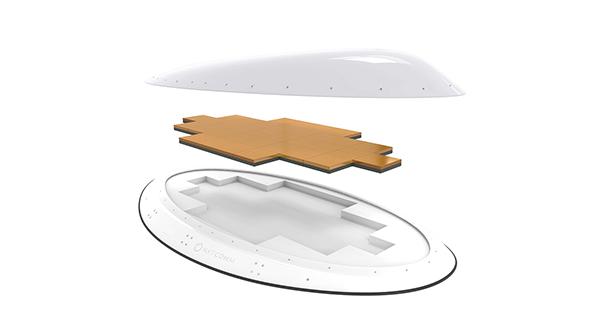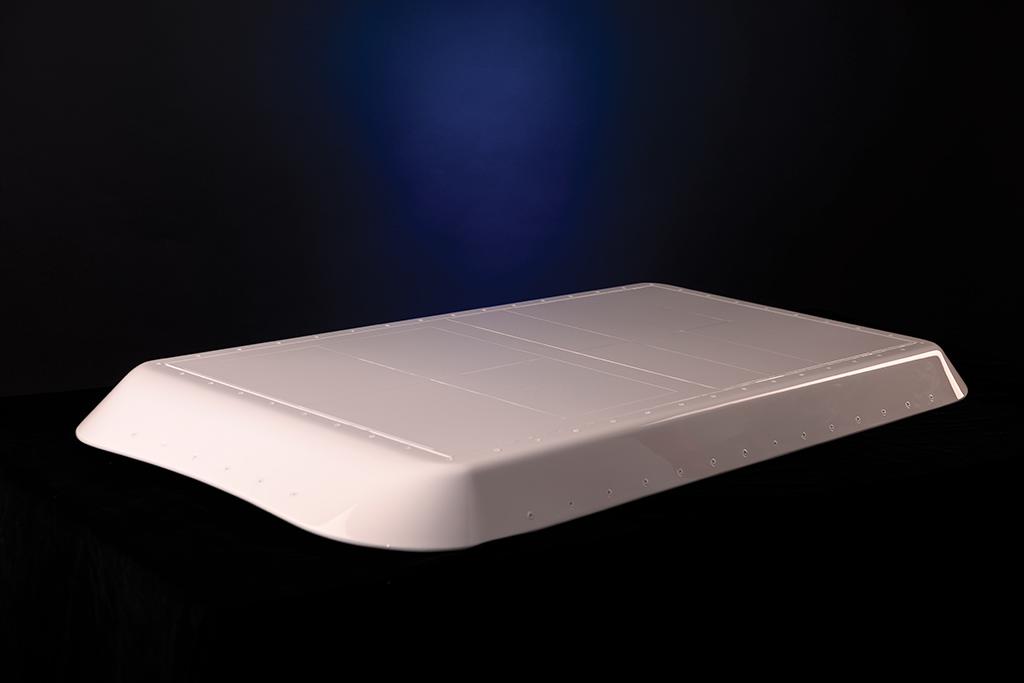Why Inflight Connectivity Antennas Are Playing Catch-Up

Inflight connectivity has revolutionized the passenger experience, but it continues to have issues with undependable internet connections and content delivery. As higher-capacity satellite networks come on-stream, however, that could change. In preparation, antenna OEMs are implementing innovative engineering concepts.
“Content providers are asking for antennas that are future-proof,” stresses Jake Sauer, vice president and general manager at Ball Aerospace. “They want to put one antenna on a plane and be confident that it will support the satellites in space today and the new NGSO [non-geostationary-orbit] satellites planned for tomorrow.”
Sauer reports that Ball Aerospace has focused on electronically steered phased-array (ESA) antennas to be satellite and constellation agnostic. He describes a novel approach to the design and production of flat-panel arrays that builds upon modular antenna building blocks called subarrays. These subarrays are combined like Lego pieces to form larger flat-panel arrays.
“This modular design enables scalability that cannot be achieved with traditional, mechanically steered antennas,” Sauer explains. “These products are architected to be modular so the transmitting and receiving antennas can be independently sized to meet specific customer needs.”
Ball Aerospace is also leveraging other innovations for its antennas, including advanced semiconductor processes such as radio frequency complementary metal-oxide semiconductors (RF CMOS), a low-cost, high-volume, digital-process technology. RF CMOS, Sauer says, provides excellent radio frequency performance and enables high levels of integration. This technology—used in the beam-forming chips and developed by Ball Aerospace partner Anokiwave—is what Ball’s ESA employs to control phase, amplitude and polarization of every element, giving the product the ability to create and move beams almost instantaneously. This allows a single antenna to communicate with geostationary (GEO), medium-Earth-orbit (MEO), highly-elliptical-orbit (HEO) and low-Earth-orbit (LEO) satellites.
“Software individually controls the performance of thousands of antenna elements, allowing beam control and shaping not available before to the commercial satcom industry,” Sauer says. “Along with that, the antenna’s RF performance benefits from advanced printed-circuit-board materials, which support higher RF performance and lower costs.”
He adds that the antenna can now meet the regulatory requirements of GEO satellites and the beam mobility requirements to communicate with a LEO satellite. “With a software upgrade, this same antenna can be configured to work with future satellite constellations and waveforms,” Sauer points out.
Playing Catch-Up
At this time, antenna technology is largely in catch-up mode, according to David Horton, co-founder and CEO of NXT Communications (Nxtcomm) in Atlanta. Horton, in fact, likens inflight connectivity (IFC) development to “a game of leapfrog.”
“The satellite operators invested a lot of money in new high-throughput satellites,” he says. “However, the ground segment—the teleport side of things—hadn’t made the strides they needed to interface with them. By the time the satellite technology and the ground infrastructure caught up, the on-aircraft antenna hardware was not where it needed to be. Today, we have relatively poor-performing antennas on airplanes.”
To address performance issues, Nxtcomm expects to roll out AeroMax, initially with a Ku-band antenna, by the fourth quarter of 2021, and a Ka-band version by the spring of 2022.
As Horton explains, AeroMax will be able to work with all satellite constellations, with the capability to transition seamlessly among them, and yet deliver consistent, uninterrupted connectivity in flight. To do that, AeroMax uses an ESA, incorporating a single flat panel. Less than 2 in. thick, the installed antenna resides within a radome that sits below the boundary layer, reducing drag. According to Horton, it is the first true flat-panel ESA developed for the commercial aviation market.
“This innovation, embedded within our fragmented aperture technology, makes this possible,” Horton notes. “Also our proprietary algorithm enhances beam forming and beam steering, especially important for LEO, MEO and HEO. All other antennas in the market—either the mechanically steered parabolic or the quasi ESAs—are dependent on multiple antennas for non-GEO operation.”
Horton adds that the economics of maintaining mechanically steered antennas are challenging: “ESAs are more efficient and reliable than mechanical-array systems, with no moving parts or gears to fail.”
Horton reports that Nxtcomm’s fragmented aperture technology is core to its antenna’s functionality. “AeroMax is fundamentally manufactured as a printed circuit board. “Our technology has a smaller LRU [line-replaceable unit] count and features consolidated electronics. We don’t waste space under the radome, which is a huge benefit of our flat-panel design.”
Asked if content providers will move away from legacy GEO satellites, Horton says he believes that they will use all available satellite architectures. “The difference will be in what percentage,” he notes. “Right now, we are GEO dominant, but over the course of time, the mix of bits delivered from each of those architectures will change. That’s why it’s important to have an antenna that does it all.”

Mechanically Steered Versions
Although ESA technology has its advocates, at least one OEM differs. Greg Otto, vice president at ThinKom Solutions, has manufactured mechanically steered, variable-inclination, continuous transverse stub (VICTS) phased-array antennas, which Otto says have proved to be extremely reliable and cost-effective.
To illustrate, Otto reports that before the COVID-19 pandemic, more than 1,500 aircraft were flying with ThinKom’s Ku3030 VICTS antenna privately labeled by Gogo for its 2Ku IFC service. Before the pandemic, the antenna accumulated more than 16 million hr. of operation with a mean time between failures of approximately 100,000 hr. “The antenna has provided gap-free, pole-to-pole coverage on all aircraft types, at all altitudes and with a low-profile radome,” he says.
According to Otto, electronically scanned array antennas, though in development for decades, have been unable to overcome numerous technological challenges that limit their efficiency, cost effectiveness, excessive power demands and poor low-elevation performance. “ESAs have been promised for many years, but no viable product has made it to market, and the schedules keep moving to the right,” Otto remarks.
The VICTS antenna architecture can support either Ku- or Ka-band frequencies. To that end, Otto points out that ThinKom has entered commercial production of its Ka-band ThinAir Ka2517 IFC antenna subsystem, including the entire outside antenna equipment (antennas, adapter plate, radome and fairing) as well as the inside antenna equipment—specifically the Ka-band network data unit and the Ka-band radio frequency unit. The Ka2517 system has already been deployed on a fleet of U.S. military aircraft and is in production for several large IFC service providers.
Otto calls the VICTS antennas the most area-efficient phased-array antennas available in the market.
“They are low-profile [3-4 in. tall] and have extremely low front-end losses, as they are based on Thin-Kom’s patented parallel-plate antenna design,” Otto says. “Compared with electronically steered antennas, the VICTS antenna is 2-5 times more efficient, which translates into a footprint that is 50-80% smaller for a similarly performing ESA. Excluding the solid-state power block converters, the antenna and antenna controller dissipate less than 150-watt average power.”
The VICTS antennas, he adds, are designed for accelerations of up to 1,000 deg./sec.2, enabling them to switch from one satellite to another in less than 1 sec.
“That speed, which cannot be matched by parabolic dish or flat-panel gimbaled antennas, is what enables ThinKom’s VICTS antennas to interoperate effectively between GEO and NGSO constellations,” he says. “We have successfully conducted live on-air trials with our commercial, off-the-shelf Ku- and Ka-band VICTS antennas, proving that we can support seamless automatic roaming between GEO and NGSO networks.”

